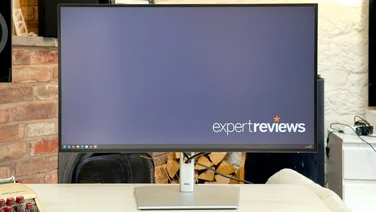To help us provide you with free impartial advice, we may earn a commission if you buy through links on our site. Learn more

- Magnificent performance
- Generous ports
- Svelte design
- Awkward buttons
- You'll have to invest in a calibrator
When you can buy a 32in, 4K monitor for less than £500, you might wonder how ViewSonic has the audacity to charge £895 for the VP3268-4K. The answer is accuracy. Or, to be more accurate about its accuracy, that it offers a pre-calibrated IPS display that – ViewSonic claims – can reproduce 100% of the sRGB spectrum.
I was keen to put such boasts to the test. On switching it from the default to sRGB mode, the most obvious change isn’t a sudden improvement in colour accuracy but that the VP3268-4K goes from being a bright screen to something much dimmer. That’s because the panel’s sRGB calibration was performed at 120cd/m² and, if you change the brightness, your results will change. Once you select sRGB mode, you’re locked to 120cd/m².
It performed magnificently in our tests. I measured an average Delta E of 0.51, which edges towards perfection and over-delivers on ViewSonic’s promise of a Delta E of less than two. Its gamma tracking and uniformity proved terrific as well – it typically deviated by less than 5% brightness, with only the corners going up to 8%. The sole black mark was when our calibrator reported that it could only display 93.8% of the sRGB gamut, not the 100% ViewSonic claims. I’m not overly concerned by this. The more important figure is that low Delta E.
While 120cd/m² is fine, I prefer a brighter screen. The VP3268-4K reached 357cd/m² at its peak, so it seems a shame not to take advantage. Luckily, the OSD allows you to jump quickly between colour modes and I spent most of my time in the Standard Color setting. Even with this on, and brightness boosted to 170cd/m², colour accuracy is strong. Average Delta E increased to 1.52, and the gamma tracking grew worse, but our colorimeter reported that it could cover 98.4% of the sRGB gamut.
All this fiddling with the controls highlights one of this monitor’s weak points: its OSD controls. There’s no rotary button, so you have to flick left and right through the main headings – such as input select, viewing mode and colour adjustments – then select which one you want, then scroll down using a different button, then select the precise option you want to change, and then change it. It’s awkward. The only consolation is that ViewSonic provides a simpler set of controls for main shortcuts, such as controlling brightness.

There are some unusual options tucked away, too. With four inputs – two HDMI, one DisplayPort and one mini-DisplayPort – you can split the screen four ways and view all of them at once. ViewSonic builds in a generous four-port USB port, plus an audio in and audio out if the built-in speaker doesn’t offer quite enough power for you. It can’t match the quality of dedicated speakers, but it was great for Skype calls and surprisingly effective when watching films.
The monitor also includes an HDR mode. This isn’t certified for content creation as I saw on the Asus ProArt PA32UC, but if you want to watch HDR films rather than make them, it’s an excellent inclusion. It’s fine for occasional gaming, too. Don’t be put off by that 14ms response time because a pixel overdrive setting tucked away in the onscreen display reduces the minimal ghosting.
READ NEXT: The best monitors you can buy
And I have more plus points to end on. First is the slimness of the bezels, which add to the display’s already svelte style. Second the flexibility, with a pivot mode, 130mm of height adjustment and a well-designed base that makes it easy to swivel the screen 60 degrees each way. Third, the fact that ViewSonic calibrates the screen for Rec 709, SMPTE-C and EBI colour spaces (for video editors), not only sRGB. Moreover, you don’t need to live with the factory calibration: using ViewSonic’s Colorbration software, it also supports hardware calibration using the popular x1-iDisplay Pro.
ViewSonic VP3268-4K review: Verdict
While the ViewSonic doesn’t have all the HDR features of the Asus ProArt PA32UC, or the high-end auto-calibration of Eizo’s ColorEdge CG277, it’s a great option due to the level of quality it offers for the price. You’ll have to invest in a £100 hardware calibrator to make sure it stays accurate, but even then the price is below £1,000. With rivals costing almost twice that, it’s a bargain if you need the accuracy on offer.







